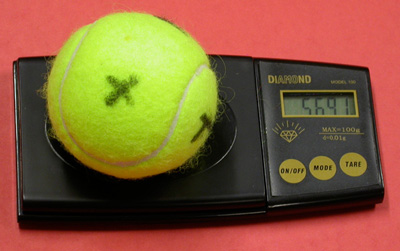How Much Does A Tennis Ball Weigh?
A tennis ball typically weighs about 57 grams or 2 ounces. Tennis balls are standard-sized rubber balls used in the sport of tennis.
They are filled with air and covered with a fuzzy felt material. The weight of a tennis ball is crucial as it affects the ball’s performance during play. The weight of the ball determines how it reacts to velocity and can impact the speed and control of shots.
Understanding the weight of a tennis ball is essential for players, coaches, and manufacturers in order to ensure fair and consistent gameplay. Additionally, knowing the weight of a tennis ball helps players choose the right equipment and maintain a level playing field.

Credit: twu.tennis-warehouse.com
The Basics Of Tennis Ball Weight
When it comes to the sport of tennis, every detail matters. From the choice of racket to the type of court surface, each factor plays a significant role in the overall gameplay experience. One such aspect that often goes unnoticed is the weight of the tennis ball. Understanding the basics of tennis ball weight can provide valuable insights into the game, helping players and enthusiasts alike optimize their performance.
Tennis ball weight variations and standards
Unlike other sports equipment, the weight of a tennis ball is subject to specific variations and standards. According to the International Tennis Federation (ITF), the official weight of a standard tennis ball falls between 56 and 59.4 grams (2 and 2.1 ounces). This stringent weight range is crucial to ensure fair gameplay, as it prevents any significant advantage or disadvantage to players.
It is worth noting that the weight of a tennis ball may vary slightly across different brands and models. These minor variations can impact the ball’s bounce, feel, and overall performance on the court. Players, therefore, need to familiarize themselves with the specific weight standards set by the ITF and ensure that they are using balls within the approved range.
Importance of weight in tennis gameplay
The weight of a tennis ball plays a vital role in determining its flight path, bounce, and interaction with the racket. A heavier ball generally tends to have a more predictable trajectory, making it easier for players to anticipate and react during rallies. On the other hand, a lighter ball may be faster and more difficult to control, demanding greater precision and agility from the players.
Moreover, the weight of the ball impacts the amount of force required to hit it. A heavier ball may require players to generate greater power and swing speed, while a lighter ball may be easier to manipulate in terms of spin and placement. The choice of ball weight, therefore, is a strategic decision that often depends on a player’s playing style, the court surface, and personal preference.
Factors affecting tennis ball weight
The weight of a tennis ball can be influenced by various factors. One such factor is the materials used in its construction. Traditional tennis balls are made of a rubber core covered with a layer of wool or synthetic felt. The composition and density of these materials can contribute to slight variations in weight.
Furthermore, external factors such as temperature and altitude can affect the weight of a tennis ball. In colder conditions, the ball may become slightly heavier, potentially altering its flight characteristics. Similarly, at higher altitudes, the reduced air density can impact the ball’s weight and bounce. Players should take these factors into consideration when selecting and preparing tennis balls for a match.
The Standard Weight Of Tennis Balls
Have you ever wondered how much a tennis ball weighs? Well, in this blog post, we will dive into the fascinating world of tennis ball weights. The weight of a tennis ball may seem like a small detail, but it plays a crucial role in the game. From the official standard weight to the evolution of weight over time, we will explore it all. So, let’s jump right in!
Exploring the official weight of tennis balls
The official weight of a tennis ball is determined by the International Tennis Federation (ITF), the governing body for the sport. According to their regulations, a standard tennis ball must weigh between 56.0 grams and 59.4 grams (2.0 ounces and 2.1 ounces).
This standard weight ensures consistency and fairness in the game. It allows players to predict and adjust their shots accordingly, as they know what to expect from the ball in terms of weight and bounce.
The evolution of standard weight over time
As with any other sports equipment, tennis ball weights have evolved over time. In the early days of tennis, balls were made of solid rubber and had a significantly heavier weight compared to today’s standards.
The first tennis balls used in official tournaments weighed around 112 grams (4 ounces). Over the years, advancements in technology and materials resulted in lighter and more durable balls.
In the 1970s, the transition from solid rubber to pressurized balls began. These pressurized balls were lighter, offering improved playability and enhanced bounce. The standard weight was then set at the range we know today, between 56.0 grams and 59.4 grams.
Comparison of different ball types and weights
While the official standard weight remains consistent, there are variations in tennis balls used for different playing surfaces and skill levels. Let’s take a closer look:
| Ball Type | Weight Range | Surface |
|---|---|---|
| Regular Duty | 56.0-59.4 grams | Clay or indoor carpet |
| Extra Duty | 56.0-59.4 grams | Hard court or grass |
| Training/Practice Balls | 58.0-60.0 grams | Various surfaces |
As you can see, the weight ranges are similar among different ball types, with slight variations to accommodate specific playing conditions. These variations ensure optimal performance and consistency on different surfaces.
So, the next time you pick up a tennis ball, remember that its weight has been finely calibrated to provide a fair and enjoyable game. Whether you’re playing on clay, grass, or a hard court, the weight of the ball remains a vital factor in the world of tennis.
The Impact Of Tennis Ball Weight On Performance
When it comes to tennis, every small detail can make a significant difference in the game. One such crucial factor is the weight of the tennis ball. Many players underestimate the importance of this seemingly insignificant attribute, but understanding how weight affects various aspects of the game can lead to a better performance overall.
How weight affects ball bounce and trajectory
The weight of a tennis ball directly affects its bounce and trajectory. It plays a vital role in determining how high the ball will bounce off the ground and how it will travel through the air. Generally, a heavier ball will have a lower bounce and a flatter trajectory compared to a lighter ball.
With a heavier ball, players may have to adjust their timing and footwork accordingly to account for the lower bounce. This can impact their ability to execute effective shots, as they may need to modify their swing and contact point to compensate for the different trajectory.
On the other hand, a lighter ball tends to bounce higher and follow a more arched path. It can allow players to generate more topspin and create a sharper angle on their shots. However, controlling the additional bounce and spin can also be a challenge, as it requires precision and proper technique.
Influence of weight on player technique and strategy
The weight of the tennis ball can significantly influence a player’s technique and strategy. A heavier ball can require players to utilize more strength and power in their shots, focusing on generating greater momentum and hitting through the ball. This can be advantageous for players with a more aggressive playing style, as it allows them to hit with more pace and penetration.
On the other hand, a lighter ball can favor players who rely on finesse, touch, and precision. It allows for quicker racket acceleration, which can be beneficial for executing drop shots, lobs, and slices. Additionally, a lighter ball can promote a faster pace of play, forcing players to think and react more swiftly to maintain control of the game.
Adjusting to different ball weights for optimal performance
Adapting to different ball weights is crucial for achieving optimal performance in tennis. Whether you’re playing with a heavier or lighter ball, it’s essential to understand and accommodate the variations in bounce, trajectory, and player requirements.
Developing the ability to adjust your technique, footwork, and timing based on the weight of the ball can provide a competitive edge. It allows you to maximize your strengths and exploit your opponent’s weaknesses. Additionally, practicing with balls of different weights can help improve your overall game, as it challenges and diversifies your skill set.
Ultimately, the weight of a tennis ball may not be the first thing that comes to mind when thinking of game-changers, but it can undoubtedly influence the outcome of a match. By considering the impact of weight on ball bounce, trajectory, player technique, and strategy, you can make more informed decisions and elevate your game to new heights.
Frequently Asked Questions For How Much Does A Tennis Ball Weigh?
How Many Ounces Does A Tennis Ball Weigh?
A tennis ball typically weighs around 2 ounces.
How Many Grams Does A Tennis Ball Weight?
A tennis ball weighs 58 to 60 grams.
How Much Does A Can Of Tennis Balls Weigh?
A can of tennis balls typically weighs around 1 pound.
What Is The Mass Of A Tennis Ball?
The mass of a tennis ball is generally around 57 grams.
How Much Does A Tennis Ball Weigh?
A tennis ball typically weighs between 2 and 2. 3 ounces, providing optimum performance and bounce on the court.
What Is The Standard Weight Of A Tennis Ball?
The standard weight of a tennis ball is 2. 5 ounces, but for recreational play and training, a slightly lighter weight is commonly used.
Conclusion
The weight of a tennis ball is a crucial factor in ensuring a fair and balanced game. Understanding its standard weight of 2. 7 to 2. 83 ounces is essential for players and enthusiasts alike. Whether you’re a professional athlete or a casual player, knowing the weight of a tennis ball ensures you can improve your skills and enhance your game.
So, next time you step onto the court, remember the importance of the tennis ball’s weight and how it can impact your performance.







